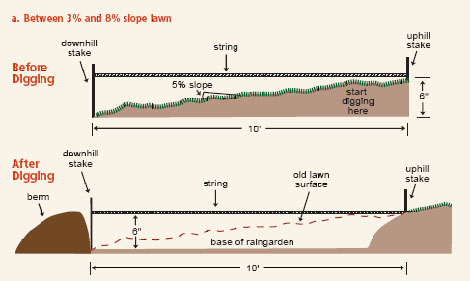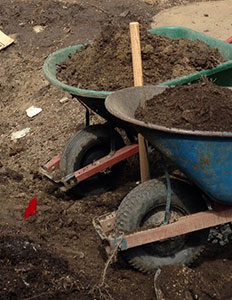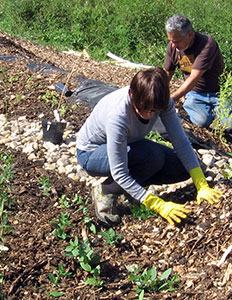Site prep. Step by step.
You've picked the site for your rain garden and you're ready to grab a shovel. But before you break ground, you've got a little prep work to do.
Find out where the lines for water, sewer, electricity, natural gas, telephone, cable, and storm sewers are buried. You'll need to stay at least two feet from them. If in doubt, call 811 or check with paonecall.org.
Now, define the perimeter of your garden. You can put stakes, flags, rope, or a garden hose along the edge, or spray a non-toxic paint, such as the type used on soccer fields. While the shape is up to you, a good rule of thumb is to make the length about twice the width—consider a kidney or teardrop shape. The wider side should face uphill so it can catch as much water as possible.
Double check the size needed for your garden by using our rain garden Calculator.
If necessary, you should replace, repair, or relocate your gutters and downspouts to ensure that water will actually reach your garden.
Start digging at the uphill side until you've reached the depth you need (again, check with the Calculator for information on garden depth).
If working on a slope, soil removed from the uphill side of the garden may be added to the downhill side to create a berm. This will reduce the amount of digging you need to do. Give the berm gently sloping sides and compact the dirt so it won't erode. You can plant grass, add plants or additional flower, or cover it with mulch.
Once you've prepared the depression, use a carpenter's level to make sure it's even. A level string across the entire garden site also works well as a gauge. The bottom (deepest portion) of the garden should be level in all directions. This increases the total area in which water will drain into the underlying soil.
Once the garden is dug to the proper depth and leveled, begin to loosen the soil to prepare for planting. If your location contains poor soil or high amounts of clay, this is the appropriate time to make soil amendments. Tilling sand and compost into the existing soil will increase porosity and improve drainage.
Now you're ready to start planting. Make sure to plant from the center out so that you do not compact the soil you just loosened. If using a wheelbarrow, consider placing a plank down to distribute the weight from the wheel.



